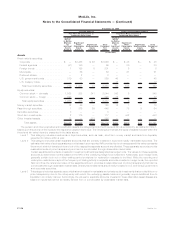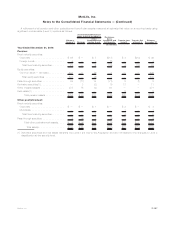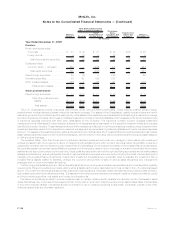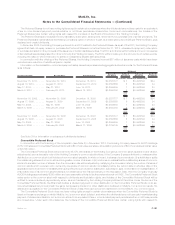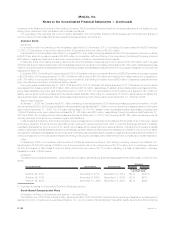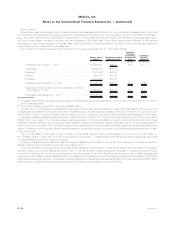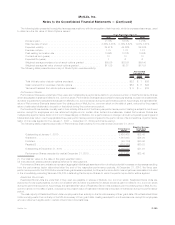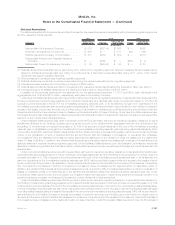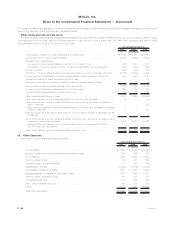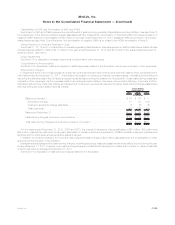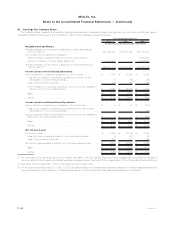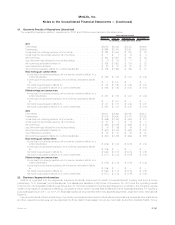MetLife 2010 Annual Report Download - page 225
Download and view the complete annual report
Please find page 225 of the 2010 MetLife annual report below. You can navigate through the pages in the report by either clicking on the pages listed below, or by using the keyword search tool below to find specific information within the annual report.
The following table presents a summary of Restricted Stock Unit activity for the year ended December 31, 2010:
Restricted Stock
Units
Weighted Average
Grant Date
Fair Value
Outstanding at January 1, 2010 . . . . . . . . . . . . . . . . . . . . . . . . . . . . . . . . . . . 393,362 $28.05
Granted(1) . . . . . . . . . . . . . . . . . . . . . . . . . . . . . . . . . . . . . . . . . . . . . . . . . 607,200 $32.32
Forfeited.................................................. (31,275) $27.31
Payable(2)................................................. (32,115) $63.32
Outstanding at December 31, 2010 . . . . . . . . . . . . . . . . . . . . . . . . . . . . . . . . 937,172 $29.63
Restricted Stock Units expected to vest at December 31, 2010 . . . . . . . . . . . . . . 937,172 $29.63
(1) The total fair value on the date of the grant was $20 million.
(2) Includes both shares paid and shares deferred for later payment.
Statutory Equity and Income
Except for American Life, each insurance company’s state of domicile imposes minimum risk-based capital (“RBC”) requirements that
were developed by the NAIC. The formulas for determining the amount of RBC specify various weighting factors that are applied to financial
balances or various levels of activity based on the perceived degree of risk. Regulatory compliance is determined by a ratio of total adjusted
capital, as defined by the NAIC, to authorized control level RBC, as defined by the NAIC. Companies below specific trigger points or ratios are
classified within certain levels, each of which requires specified corrective action. Each of the Holding Company’s U.S. insurance
subsidiaries exceeded the minimum RBC requirements for all periods presented herein.
American Life does not write business in Delaware or any other domestic state and, as such, is exempt from RBC by Delaware law.
American Life operations are regulated by applicable authorities of the countries in which the company operates and are subject to capital and
solvency requirements in those countries.
The NAIC has adopted the Codification of Statutory Accounting Principles (“Statutory Codification”). Statutory Codification is intended to
standardize regulatory accounting and reporting to state insurance departments. However, statutory accounting principles continue to be
established by individual state laws and permitted practices. The New York Insurance Department (the “Department”) has adopted Statutory
Codification with certain modifications for the preparation of statutory financial statements of insurance companies domiciled in New York.
Modifications by the various state insurance departments may impact the effect of Statutory Codification on the statutory capital and surplus
of the Holding Company’s U.S. insurance subsidiaries.
Statutory accounting principles differ from GAAP primarily by charging policy acquisition costs to expense as incurred, establishing future
policy benefit liabilities using different actuarial assumptions, reporting surplus notes as surplus instead of debt and valuing securities on a
different basis.
In addition, certain assets are not admitted under statutory accounting principles and are charged directly to surplus. The most significant
assets not admitted by the Company are net deferred income tax assets resulting from temporary differences between statutory accounting
principles basis and tax basis not expected to reverse and become recoverable within three years. Further, statutory accounting principles do
not give recognition to purchase accounting adjustments.
Statutory net income (loss) of MLIC, a New York domiciled insurer, was $2,066 million, $1,221 million and ($338) million for the years
ended December 31, 2010, 2009 and 2008, respectively. Statutory capital and surplus, to be filed with the Department, was $13.2 billion and
$12.6 billion at December 31, 2010 and 2009, respectively.
Statutory net income of American Life, a Delaware domiciled insurer, of approximately $800 million will be reported in the Statutory Annual
Statement for the year ended December 31, 2010. Statutory capital and surplus, to be filed with the Delaware Insurance Department was
approximately $4.0 billion at December 31, 2010.
Statutory net income of MICC, a Connecticut domiciled insurer, was $668 million, $81 million and $242 million for the years ended
December 31, 2010, 2009 and 2008, respectively. Statutory capital and surplus, to be filed with the Connecticut Insurance Department, was
$5.1 billion and $4.9 billion at December 31, 2010 and 2009, respectively.
Statutory net income of Metropolitan Property and Casualty Insurance Company (“MPC”), a Rhode Island domiciled insurer, was
$273 million, $266 million and $308 million for the years ended December 31, 2010, 2009 and 2008, respectively. Statutory capital and
surplus, to be filed with the Insurance Department of Rhode Island, was $1.8 billion at both December 31, 2010 and 2009.
Statutory net income of MTL, a Delaware domiciled insurer, was $151 million, $57 million and $212 million for the years ended
December 31, 2010, 2009 and 2008, respectively. Statutory capital and surplus, to be filed with the Delaware Insurance Department
was $805 million and $867 million at December 31, 2010 and 2009, respectively.
F-136 MetLife, Inc.
MetLife, Inc.
Notes to the Consolidated Financial Statements — (Continued)


